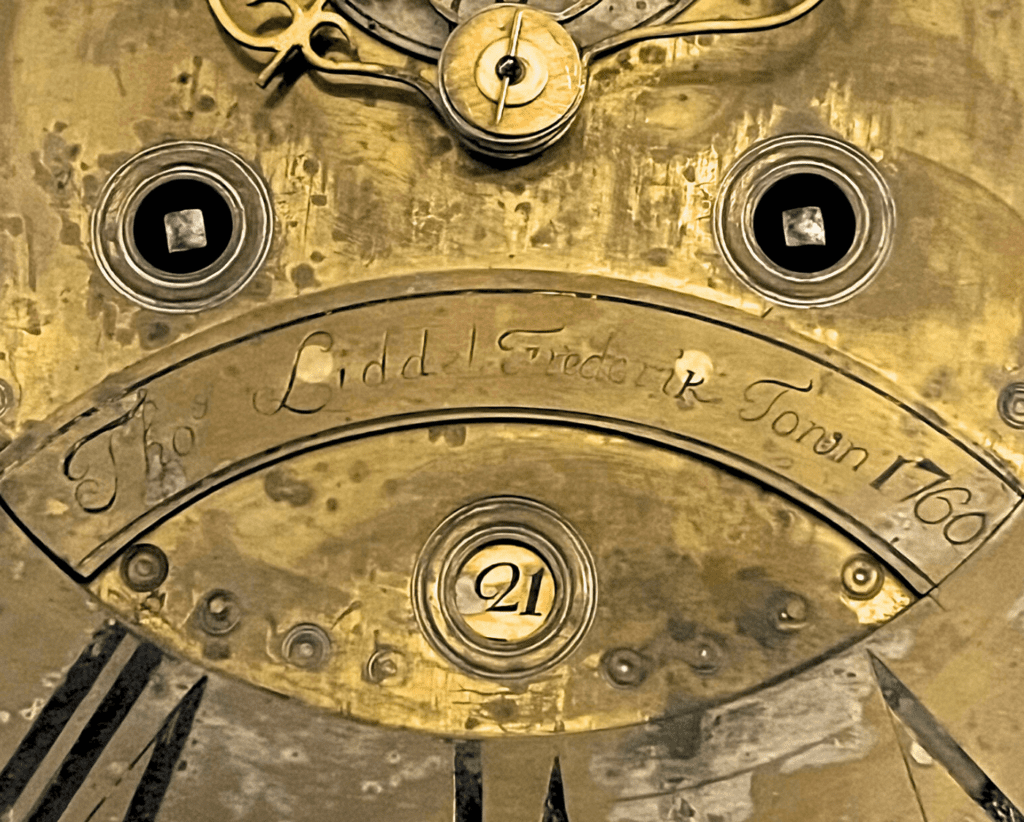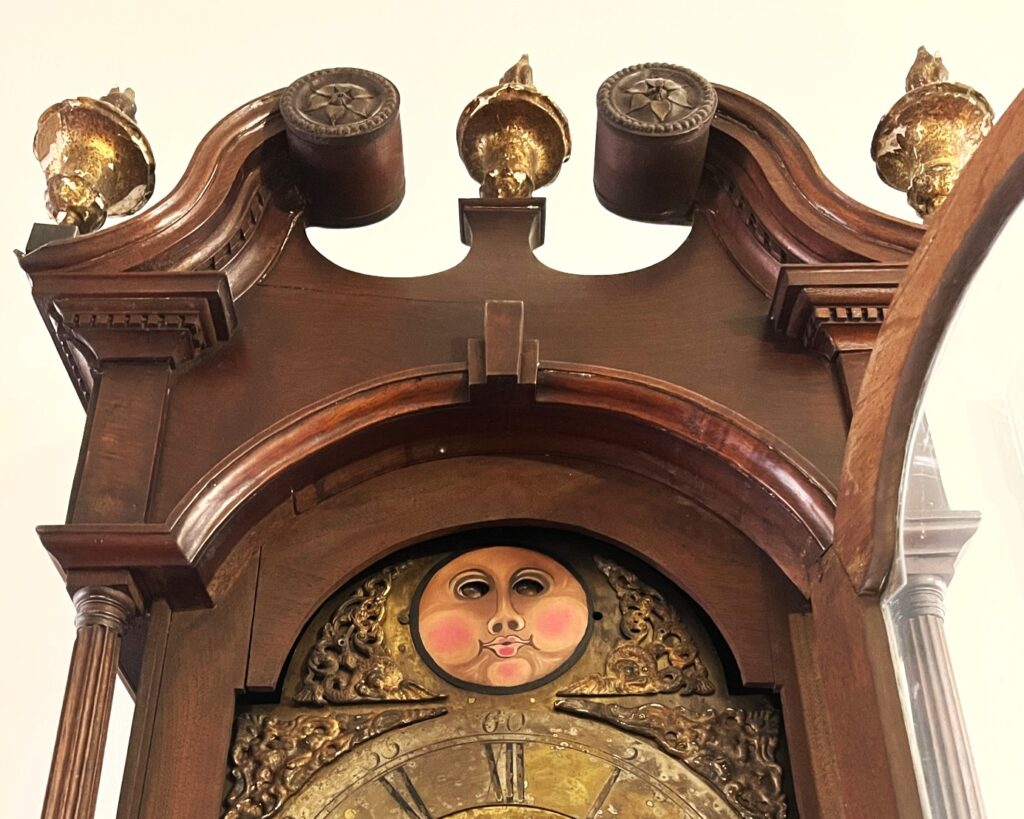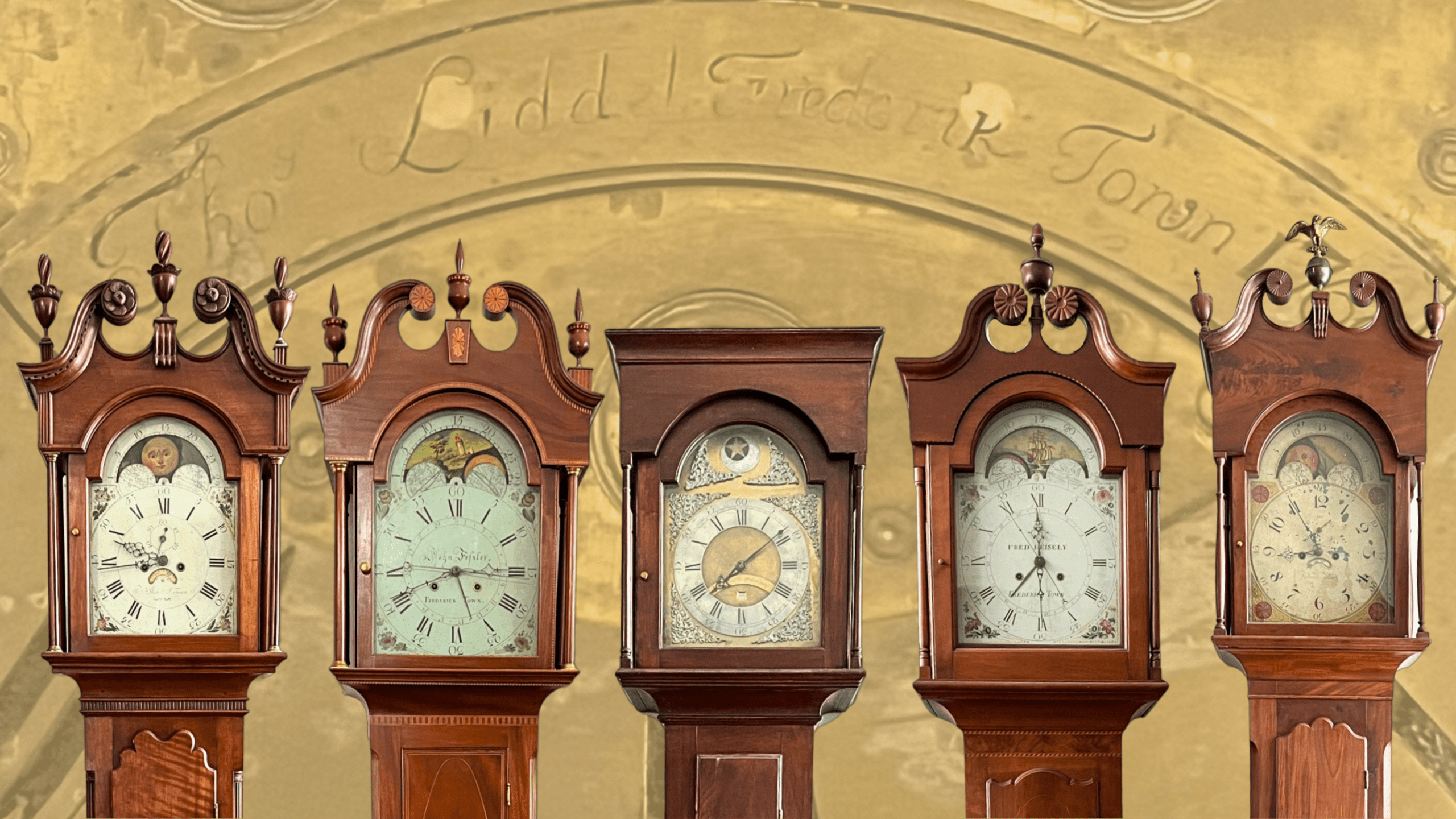
Tall Case Clocks of Frederick County
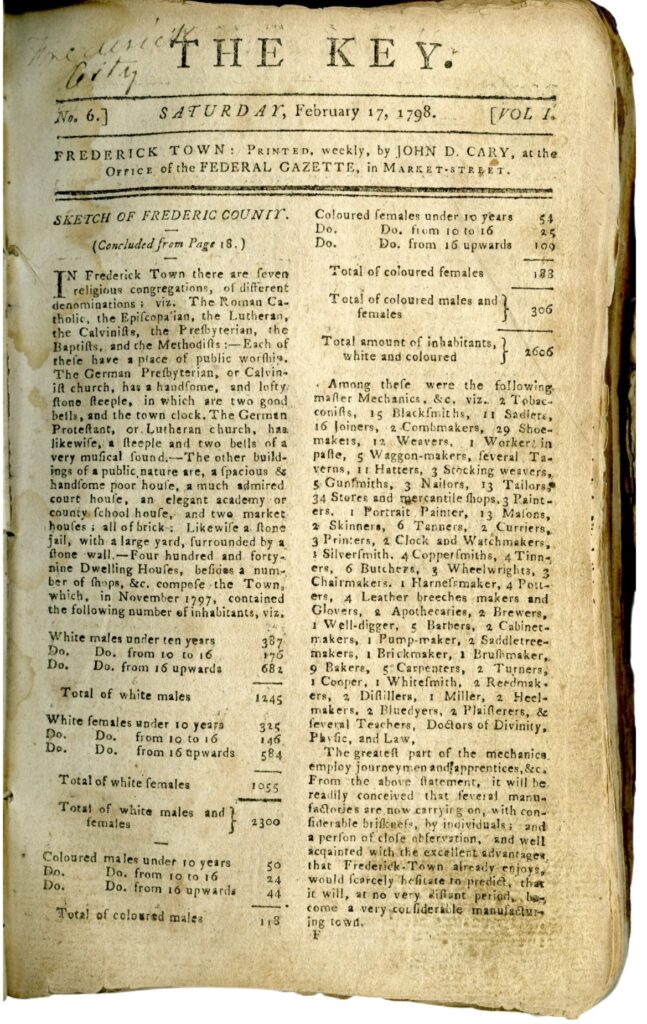
A list of tradesmen in Frederick City from The Key, February 17, 1798 lists two clockmakers (likely John Fessler, Sr., and Valentine Steckell), two cabinetmakers, and sixteen joiners.
Tall case clocks were more than devices for keeping track of time for the people who built and owned them in Frederick County during the eighteenth and early-nineteenth centuries. Representing the hands of many skilled artisans and tradesmen, these clocks were symbols of status and examples of technological advancement.
The names which appear on the dials of these clocks are those of the clockmakers who handcrafted the gears, pinions, bearings, bells, and other internal components which power the timepiece and striking mechanisms. Many Frederick County clockmakers were trained by master craftsmen in southeastern Pennsylvania. In similar fashion, they took on apprentices in their shops to teach the trade to a new generation of clockmakers. Beyond the production of clockworks, many Frederick clockmakers also produced scientific instruments, watches, surveying devices, and silverware.
While the identities of the clockmakers are preserved, we know very little about the other tradesmen who constructed the cases in which the clocks are housed. Cabinetmakers and joiners crafted these beautiful cases from a variety of woods. Conrad Doll, one of Frederick’s most prolific cabinetmakers, worked with oak, walnut, beech, poplar, and cherry wood to craft desks, cabinets, and other pieces of furniture. The cases display a range of decorative traditions, including motifs of classical architecture such as columns, broken pediments, arches with keystones, and geometric forms, blended with more naturalistic curving profiles and floral designs reminiscent of Pennsylvania German style.
The tall case clocks in this exhibit demonstrate the range and highly-refined skills exhibited by Frederick County clockmakers and cabinetmakers between 1760 and 1830.
Clockmakers in Frederick County (1760-1830)
- Thomas Liddel
- John Myer
- Elijah Evans
- Frederick Heisely
- John Fessler, Sr.
- Valentine Steckell
- George Schnertzel
- Valentine Bach
- Jacob Grove
- John Hoover
- McCaleb Family
- Daniel Martz
- George Miller
- John Riley
- Peter Shute
- John Welker
- Frederick Nusz
- John Fessler, Jr.
Cabinetmakers in Frederick County (1760-1830)
- Conrad Doll
- Emanuel Carpenter
- John Turston
- George Shope
- Philip Woodring
- Godfrey Leatherman
- Matthias Hamersle
- David Plain
- Charles Yeager
- Peter Leatherman
- Henry Slinluff
- John Davis
- Godfrey Brown
Frederick County Tall Case Clocks

Thomas Liddel
The oldest tall case clock preserved in the collection of Heritage Frederick was made by Thomas Liddel in Frederick Town in 1760. The dial of the clock is made of brass and decorated with applied scrollwork in the spandrels and framing the moon dial at the top. Remnants of silverleaf can be detected on the chapter ring. This is the only known example of Thomas Liddel’s work in existence. The clock descended through several generations of the Hammond Family of New Market until the late-1930s when it was sold to Marshall Lingan Etchison, a Frederick antiquarian and historian. At this time, the clock had been disassembled and stored in the attic of the Hammond House on Main Street in New Market. The restored clock was donated to the Historical Society of Frederick County in 1960 as part of the large Marshall Lingan Etchison Collection. It has been on exhibit in the museum ever since.
The clock case is one of the most detailed examples in the collection, a reflection of the rococo style popular among Philadelphia cabinetmakers in the mid-eighteenth century. Delicately curved Chippendale feet support the clock base which is decorated with an eared panel and fluted pilasters, which are replicated in the waist. The waist door culminates in a curved crown with a seashell motif. The hood is crowned with a broken pediment decorated with flowers and dentils. Three gilded urn-shaped finials complete the elaborate case.
The Thomas Liddel clock was donated to Heritage Frederick by Marshall Lingan Etchison in memory of William H.B. and Josephine Pearre Etchison.
John Myer
One of the earliest clockmakers with a documented presence in Frederick County is John Myer. He was born in Lancaster, Pennsylvania, on August 28, 1744. Exactly when he moved to Frederick is not known. John Myer died on August 24, 1772, at the age of 28 from tuberculosis. This clock likely dates from the years between 1765 and 1772. Myer may have learned his trade from another Frederick County clockmaker, George Schnertzel, to whom a payment was made out of Myer’s estate after his death. The inventory of Myer’s estate included “part of work done to a clock,” twelve pounds of brass, clock chain, and “sundry clock tools.”
John Myer’s clock has the best preserved brass dial among the clocks in the Heritage Frederick Collection. Applied to the brass dial plate are silver leafed spandrel decorations and a silvered chapter ring. Scrollwork similar to the spandrels is found above the chapter ring framing a moon dial. The case is of Chippendale design and much simpler than the highly-decorative Liddel clock case.
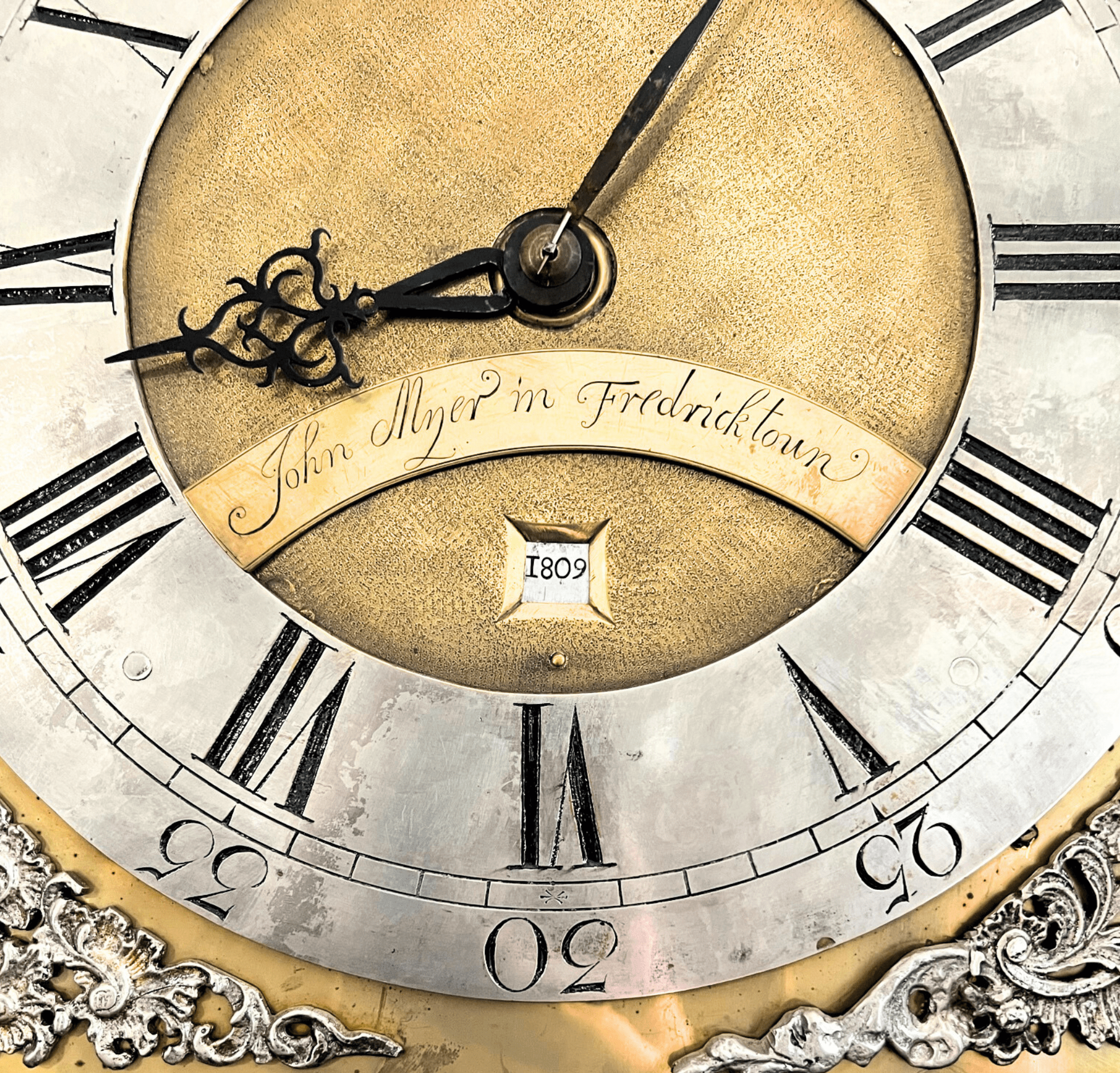
Detail of the dial showing John Myer’s signature.

The John Myer clock was donated to Heritage Frederick by Mr. and Mrs. U. Merhl Hopper in memory of Sharon Hooper.

John Fessler, Sr.
Frederick’s most prolific clockmaker was born in Switzerland in 1758. John Fessler, Sr., was two years of age when his family immigrated to Pennsylvania. Fessler came of age in Lancaster where he likely learned his trade as an apprentice to one of several master clockmakers in that city. During the Revolutionary War, John Fessler, Sr., served in the Lancaster County Militia under Captain Emmanuel Carpenter. He was residing in Frederick by the end of the war when he married Anna Elizabeth Bach at Evangelical Lutheran Church on October 20, 1782. John Fessler, Sr., took on several apprentices and taught his son, John Fessler, Jr., the trade of clockmaking. The family’s shop produced works for tall case clocks as well as watches. John Fessler, Jr., became a partner in his father’s business in 1817 and carried it on after John Fessler, Sr., died in 1820.
Two historic clocks of John Fessler, Sr., are preserved in the collection of Heritage Frederick. The earlier of these clocks (pictured at left) is housed in an unusual case displaying Pennsylvania German aesthetic with prominent scalloped moldings which frame the hood of the clock case. The original dial was most likely brass, but was replaced at some point with paper. The chapter ring, made of pewter and inscribed with John Fessler, Sr.’s, signature, has survived intact.
The second Fessler, Sr., clock in the Heritage Frederick Collection (seen below) is representative of his later work. The Federal style case is festooned with inlaid borders and designs and crowned with a broken pediment. The iron dial is painted with John Fessler, Sr.’s signature dominating the center of the chapter ring and framed by floral decorations in the spandrels.
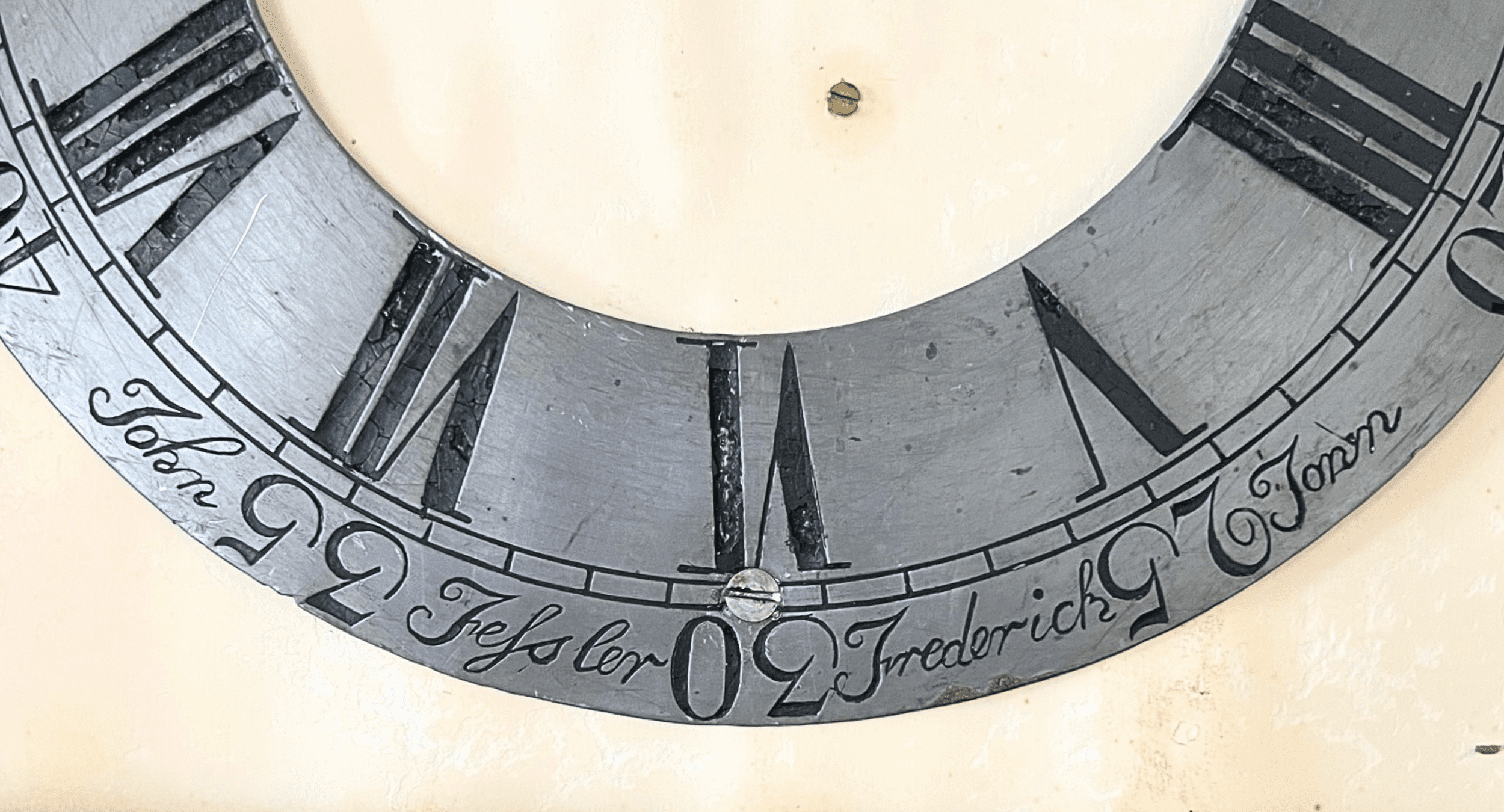
Detail of John Fessler, Sr.’s, signature on the pewter chapter ring of the clock pictured to the left.

The Fessler home (third from right) on the corner of West Patrick and South Court Streets, painted in 1820 by George Schley.
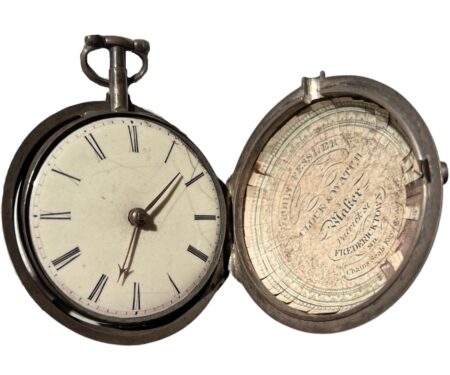
A pocket watch sold in John Fessler, Sr.’s shop.

The first John Fessler, Sr., clock was donated to Heritage Frederick by David Masser.
The second John Fessler, Sr., clock was donated to Heritage Frederick by Mr. and Mrs. U. Merhl Hopper in memory of Sharon Hooper.

Frederick Heisely
Born in Lancaster, Pennsylvania, in 1759, Frederick Heisely apprenticed with one of his hometown clockmakers, George Hoff. After serving in the Revolutionary War, Heisely married his teacher’s daughter, Catherine Juliana, and the couple moved to Frederick around 1783. Frederick made clocks and watches in his shop as well as surveying compasses and other scientific instruments. Having briefly returned to Lancaster to form a partnership with George Hoff, an advertisement of 1798 announced Heisely’s return to Frederick where he remained until 1811 when he moved to Harrisburg, Pennsylvania. Before this move, Heisely was contracted to build the works for the town clock which was placed in the new steeple atop the German Reformed Church (now Trinity Chapel) in 1807. Heisely remained in Harrisburg where he continued his business and served in local government until his death in 1843. Frederick Heisely’s works remained in the tower of Trinity Chapel until 1928 when it was replaced with an electric-powered clock. The clockworks were eventually donated by the City of Frederick to the Smithsonian Institution.
This tall case clock by Frederick Heisely features an iron dial painted with floral decorations and signed by Heisely. The case is decorated with inlay on the base and waist and crowned with a finial set between a broken pediment atop the hood.

[Above]: The town clock in the spire of Trinity Chapel, originally powered by works made by Frederick Heisely.
[Right]: Detail of the dial on the Frederick Heisely tall case clock.
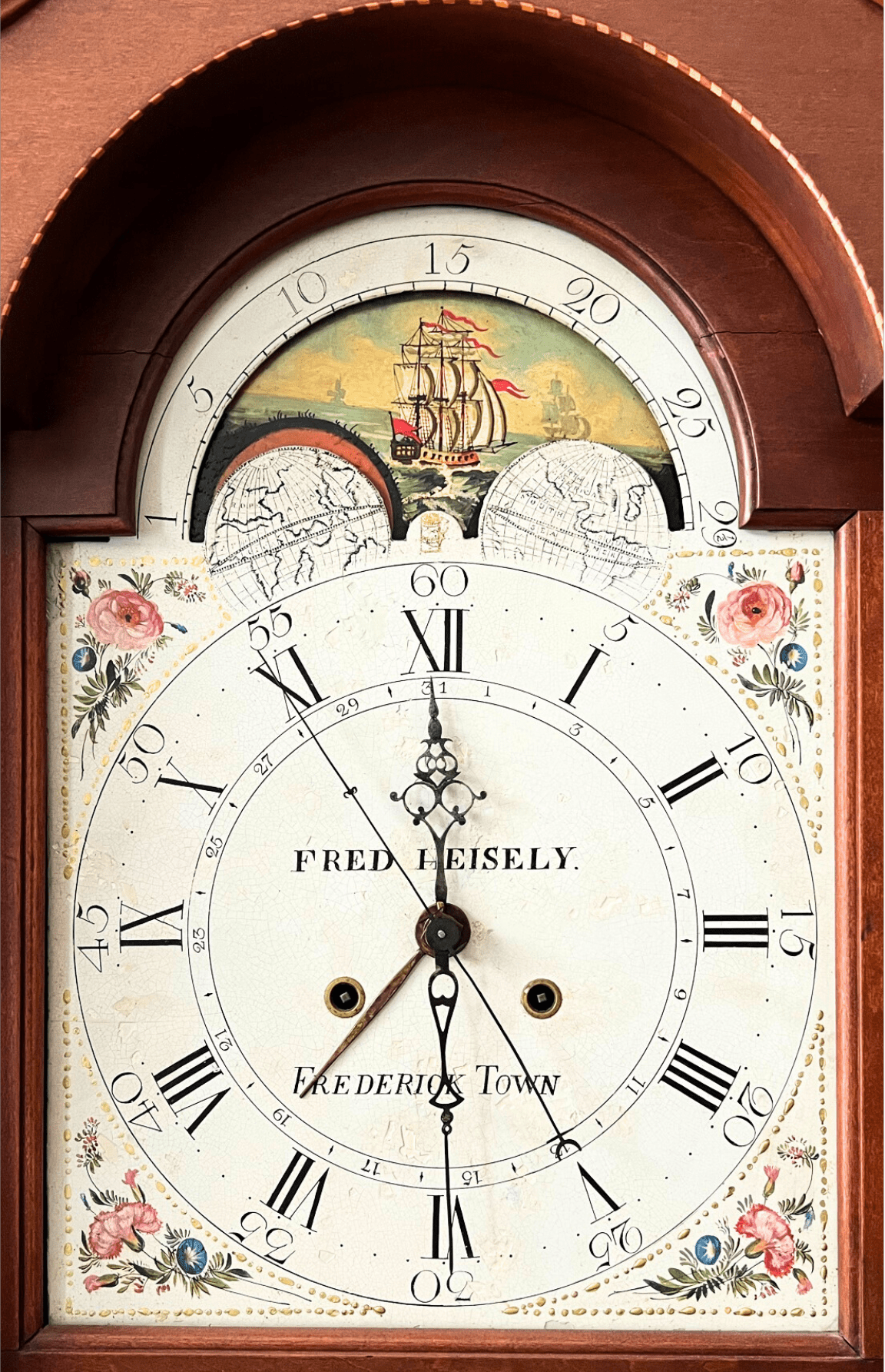
The Frederick Heisely clock was donated to Heritage Frederick by Mr. and Mrs. U. Merhl Hopper in memory of Sharon Hooper.
Valentine Steckell
The Steckell Family immigrated from Germany to Philadelphia in 1749 and settled in eastern Frederick County near Silver Run (now in Carroll County). In 1764, Valentine Steckell (grandfather of the clockmaker of the same name) purchased a lot in Frederick Town where he maintained a weaving shop. In 1772, he sold part of a lot along North Market Street to George Schnertzel, a clockmaker, who married Valentine’s daughter, Barbara. In light of this family connection, Schnertzel may have taught the younger Valentine Steckell, his nephew, the trade of clockmaking. Valentine Steckell the clockmaker was born in 1773 in Frederick. His will, dated 1796, lists his occupations as clockmaker and watchmaker, but existing examples of silverware indicate that he was also engaged in silversmithing. Steckell died at the age of 23 in December 1796.
This tall case clock made by Valentine Steckell is housed in one of the most elaborate cases among Heritage Frederick’s Collection. The base rests on delicately-curved Chippendale feet and is decorated with a shield design and fluted pilasters. The waist features similar pilasters and a “tombstone” shaped door enclosing the weights and pendulum. Steckell’s clock has an iron dial on which the chapter ring and moon dial are painted. The spandrels are decorated with flowers. The broken pediment atop the hood is heavily carved with dentils, a console, rosettes, and three finials in the shape of urns.

Detail of Valentine Steckell’s signature painted on the dial of his clock.

The Valentine Steckell clock was donated to Heritage Frederick by Mr. and Mrs. U. Merhl Hopper in memory of Sharon Hooper.


Frederick Nusz
Little is known about Frederick Nusz before his first appearance in Frederick. In 1801, the Orphans Court indentured Henry Bearshank, aged 13, to apprentice with Frederick Nusz and “learn him the trade of clockmaker.” Nusz was active in Frederick from this time until his death in 1842, making clocks, watches, and silverware. His shop was located on North Market Street, for a time next door to cabinetmaker George Shope, who may have produced some of the cases which housed Nusz’s works. Later advertisements placed by Frederick Nusz show that he also sold musical instruments, tailoring supplies, jewelry, guns, and eyeglasses. Nusz was active in city politics as well, serving at various times as tax commissioner and on the Board of Alderman.
Two tall case clocks made by Frederick Nusz are preserved in the collection of Heritage Frederick. Both clocks are housed in cases with Federal style details. The larger of the two has a broken pediment with two wooden finials and a central finial of brass in the form of an eagle with wings extended, standing atop an orb. Each clock is fitted with an iron dial which is painted in Pennsylvania German fashion with geometric and naturalistic patterns.
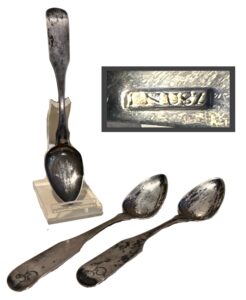
These coin silver teaspoons are stamped with Frederick Nusz’s maker’s mark.
The first Frederick Nusz clock was donated to Heritage Frederick by Monroe Pfoutz.
The second Frederick Nusz clock was donated to Heritage Frederick by Mr. and Mrs. U. Merhl Hopper in memory of Sharon Hooper.
John Fessler, Jr.
John Fessler, Jr., was born in 1787 in Frederick. He was the eldest surviving child of John Fessler, Sr., and his first wife, Anna Elizabeth Bach. Fessler, Jr., grew up learning clockmaking in his family’s shop on West Patrick Street. In 1811 at the age of 24, he established his own clock and watch business. A year later, Fessler, Jr., married Catherina Susanna Baer. The couple had five children, two of whom died at a young age. In 1817, announcements appeared in Frederick newspapers that John Fessler, Jr., had become a partner in his father’s business, which lasted until Fessler, Sr.’s, death in 1820. He carried on the family’s business and, like his father, served in city government at various times. John Fessler, Jr., and his wife had their portrait taken by a Frederick photographer before her death in 1862. He is the only Frederick County clockmaker for whom a photograph has been identified. John Fessler, Jr., died in 1869.
The tall case clock in Heritage Frederick’s Collection which is attributed to John Fessler, Jr., is housed in another fine example of Federal style cabinetmaking. The hood is crowned with a broken pediment with inlay decoration and a wooden finial. The iron dial is painted with floral and seashell motifs. Examples of silverware made by John Fessler, Jr., are also preserved at Heritage Frederick.
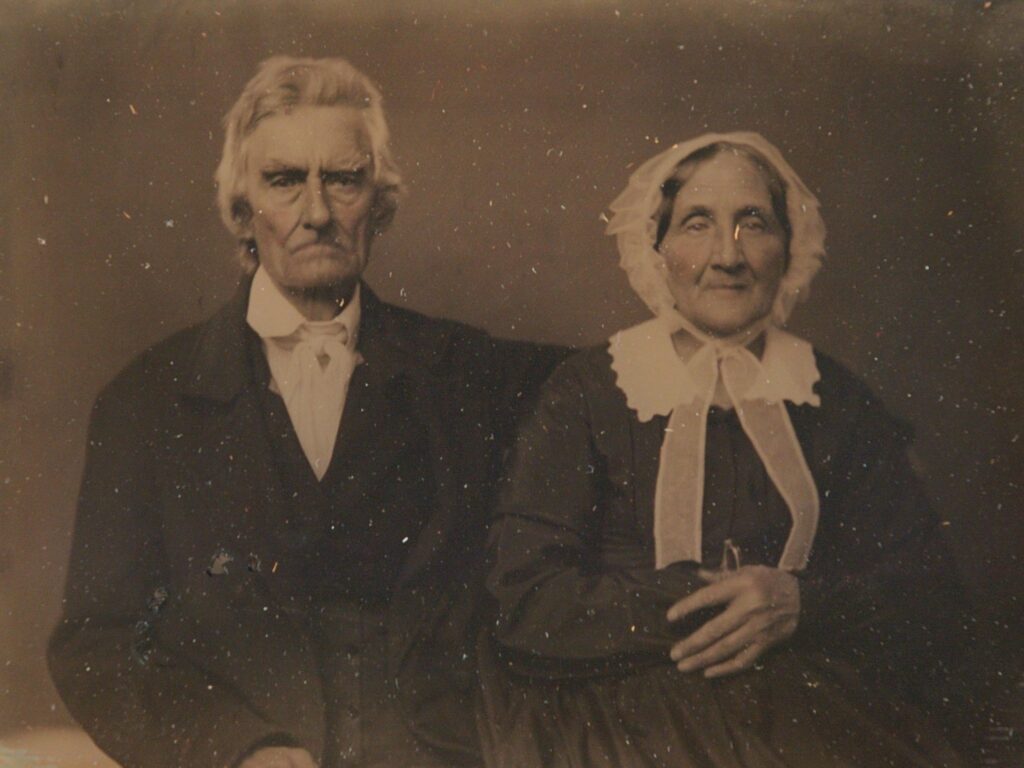
John Fessler, Jr., and his wife, Catherina Susanna Baer, circa 1860.

The John Fessler, Jr., clock was donated to Heritage Frederick by Mr. and Mrs. U. Merhl Hopper in memory of Sharon Hooper.

